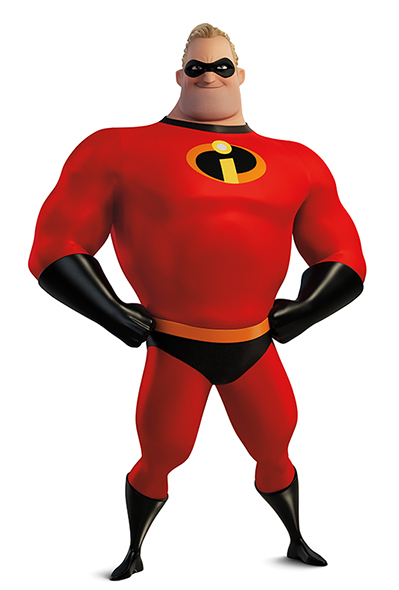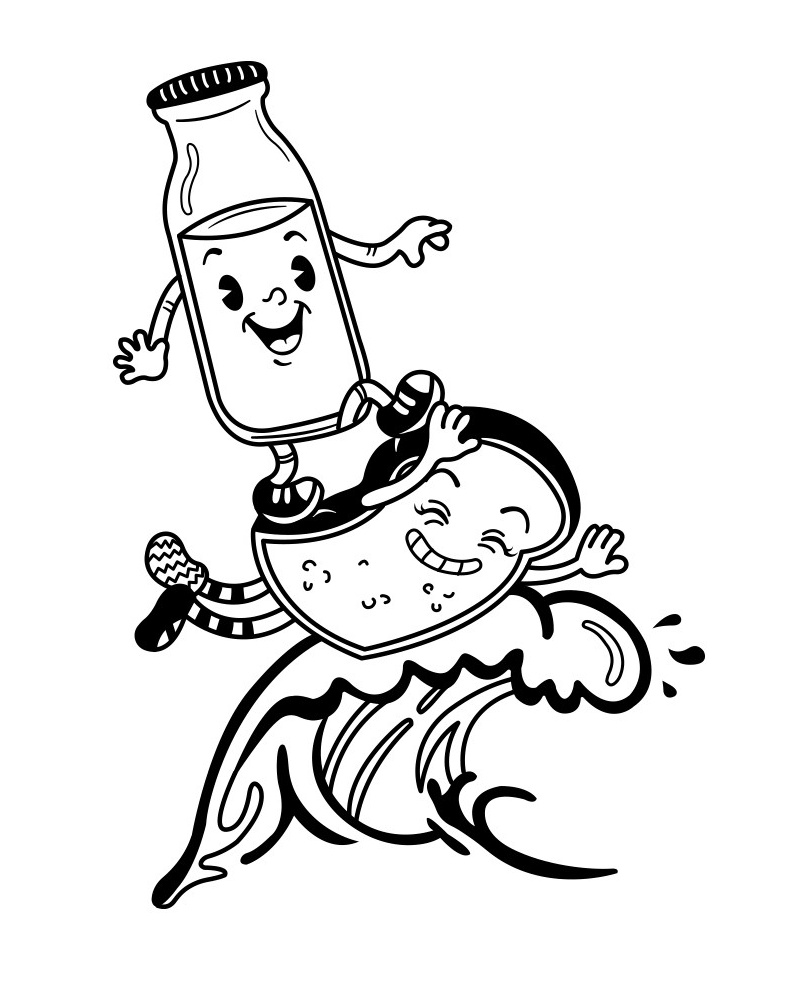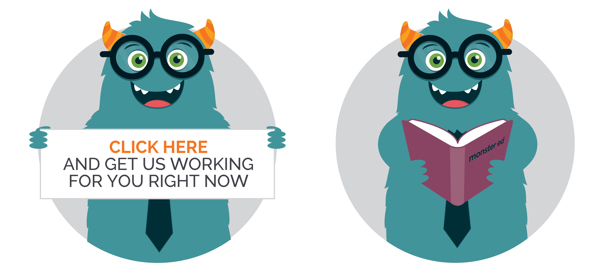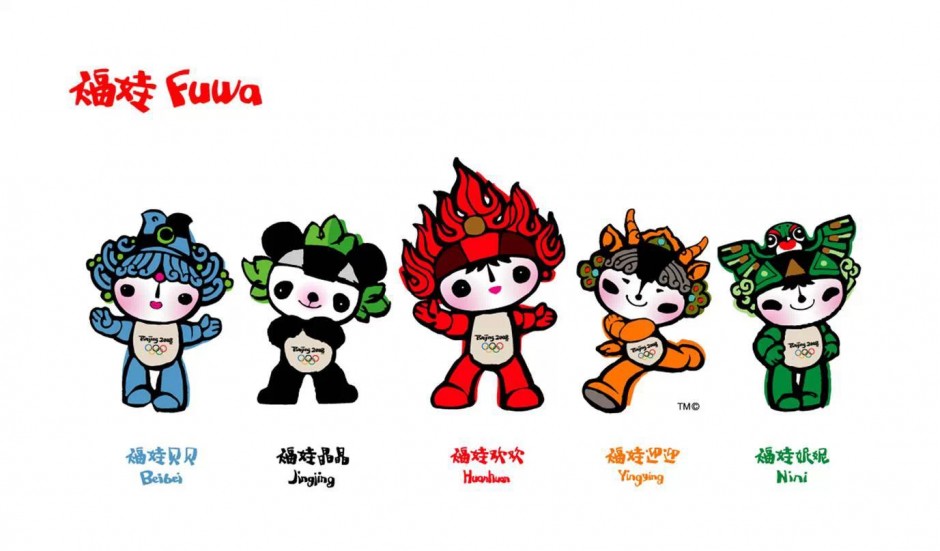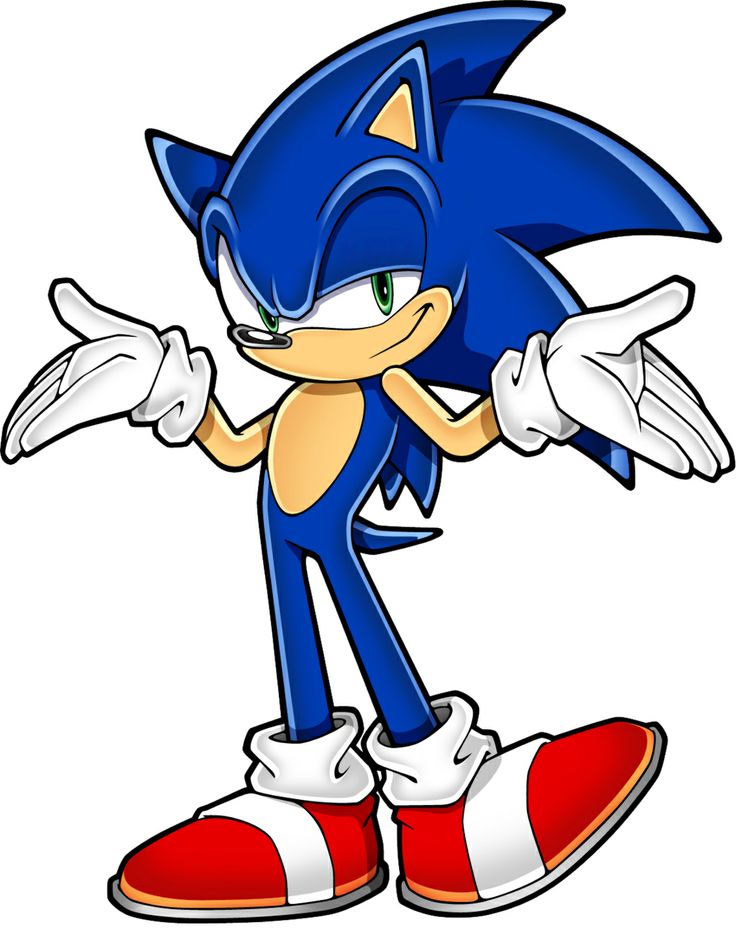How to design characters
How to design characters
39 Ultimate Character Design Tips for Beginner to Advanced Artists
Have you ever tried to design your own character and realised how tricky the process can be? A lot of work goes into a good character design so it can be difficult to know where to begin Luckily, there are a few simple character design tips you can use to greatly improve your designs!
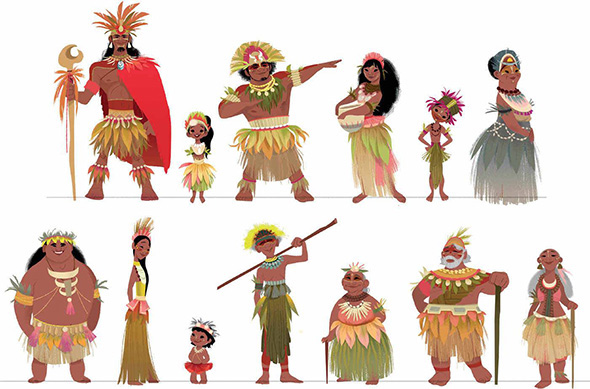
What are the 7 Steps to Great Character Design?
What is Character Design?
Character design has always had a key role in the concept-design industry. Whether you are designing for film, TV, games, advertising, or a personal project it takes a lot of creativity and skill to create an effective character.
To understand what great character designs look like, one only has to look at the work of well-known mass-media company Disney, whose iconic characters remain common household names, despite some of them being introduced as early as the 1930s.
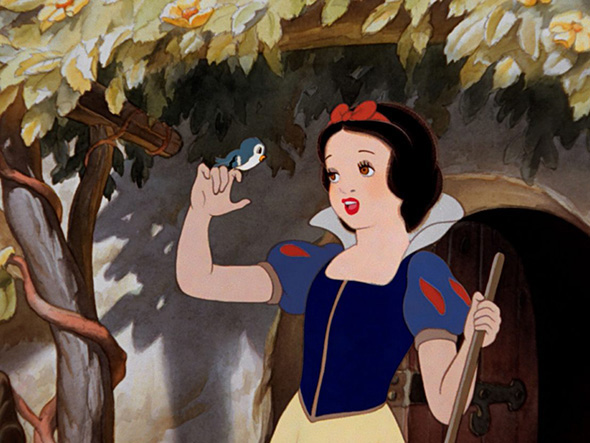
However, Disney is just one example – there are many styles that can be used to create effective characters as long as you know how to use these styles. So here are 39 character design tips and tricks to help you create your own awesome characters!
How Does Character Design Begin?
Whether you are using Adobe Illustrator, Photoshop, Procreate, or any other software or medium, your character design process will start in the same place!
Every character design begins with an idea. This idea can often be in the form of a client brief or even a personal project!
How to Find Character Design ideas?
Sometimes finding inspiration for your designs can feel impossible! But don’t fret, there are a bunch of different ways to unlock your creativity.
Get Inspired by Artists on Instagram
Looking at the amazing works of your favourite artists can really help improve your creativity and give you new techniques and ideas to try in your own work.
For example, talented artist Ross Tran, aka @rossdraws, is well-known for his digital paintings in which he takes images of himself or everyday objects and turns them into a fantastical scenes. In the below image, he used heart candy as inspiration for some beautiful character art. Why not give this a try using objects from your own house?
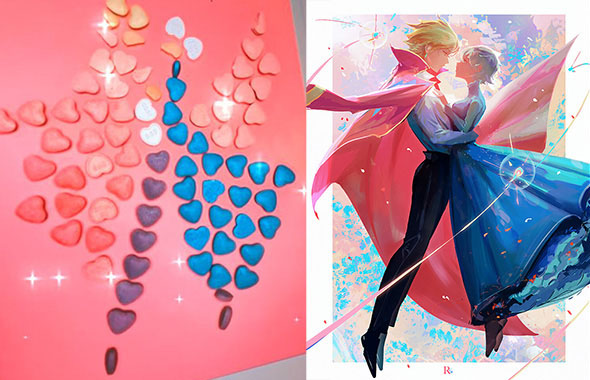
Do a Drawing Based on the Lyrics of Your Favourite Song
Music can be another awesome creative outlet and because of this, many artists find music incredibly inspiring when creating character designs. For example take this drawing by @the.flightless.artist, Isabel Burke. Isabel has turned the song ‘A Burning Hill’ by Mitski into this gorgeous design!
So, grab your headphones and listen to your favourite playlist. Try to find songs that remind you of your character and let the lyrics and melodies inspire you!
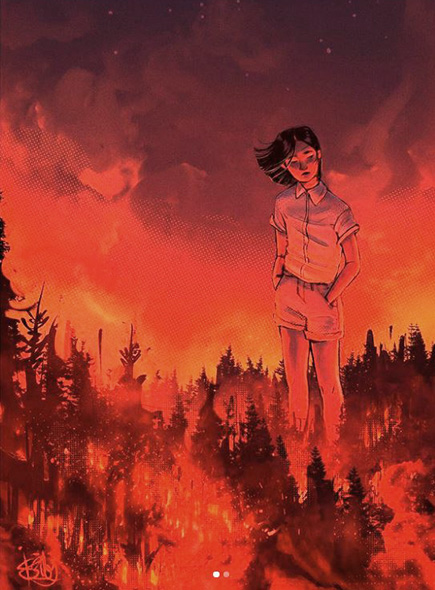
Take a Trip to Your Local Art Gallery
When was the last time you went to an art gallery? Both traditional and contemporary art can be a great inspiration when creating character designs.
A lot of art galleries offer free entry. So go find a local gallery and go check out the works they have on display! Pay attention to the different styles, textures, and colours other artists are using, and start thinking about what techniques you can incorporate into your own designs.
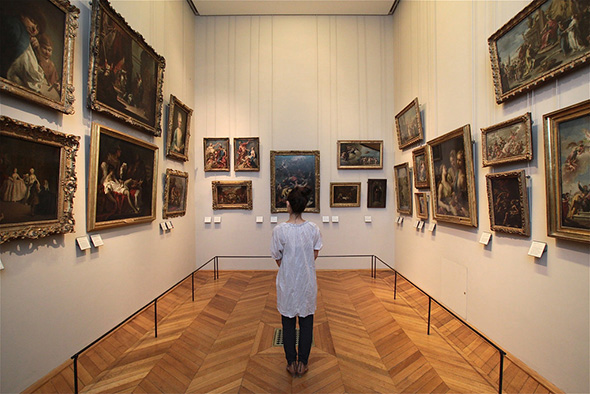
Go on a Walk
Sometimes the best remedy for an art block is to take a break from your work and do something relaxing. The outdoors provide endless forms of inspiration, from people you see around town to the beautiful natural environment.
So, if you are struggling to pin down the final concepts for your design, take a walk and see what new ideas you can find!
Do Your Research
Once you have a character idea in mind, your next step should be to start researching. Ask yourself questions like:
What is my character’s context? How does it look where they live? What would they wear for this climate? What time do they live in? What is their socio-economic status and how would this affect their design?

Once you have answered these questions, try to find as much written and visual information as possible. Compile mood boards and notes from your findings.
A well-researched character will have a lot more credibility and really resonate with their audience. When you are finished researching, you should have enough reference material to start designing your character.
A good example of how to use your reference images can be seen in this example from our ‘How to Draw a Cartoon Character Course’ by Maria Lia Malandrino.
How to Improve Your Character Drawing form?
A key part of creating good cartoon characters is having a strong understanding of form and anatomy. Some exercises to improve your skills include:
Life studies are an age-old artistic practice that is incredibly effective for improving your character design skills. An example of this is the anatomy studies of Leonardo Da Vinci. Da Vinci was dedicated to gaining a comprehensive understanding of the human form to improve his work.
What Archetype Best Fits Your Character?
When you design a character, there is a tonne of different archetypes that you can draw inspiration from. Utilising these well-known character types allows your designs to be easily understood by their audience. Many character designers utilise archetypes in their designs!
Randy Bishop’s course, ‘Fundamentals of Character Design’ does a great job of going into detail on all these archetypes and how to use them in your designs.
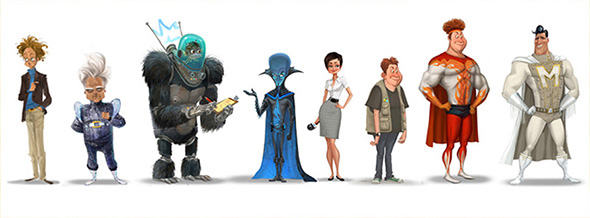
Archetypes for Memorable Character Design?
Once you are aware of these archetypes you will be able to create designs that will clearly communicate your character’s personality. If none of these categories feel quite right for your character, you can always combine multiple tropes, or subvert them completely to create endless unique designs!
Who is Your Demographic?
When you design a character it is important to know who your audience is. For example, a design that appeals to children may not always appeal to adults or vice versa. So before you start your design, take a moment to think about your audience. How old are they? Are they any gender in particular? Where do they live? Answering these questions will allow you to cater your designs more toward your audience and therefore ensure your character is engaging.

Take a look at these two designs of Raven from Teen Titans. The first design is aimed at younger children whilst the second is aimed at teenagers. As you can see, more simplified designs are preferred when designing for younger viewers.
What Shape Language Should You Use?
Shape language is a technique that communicates information about your character by using basic shapes that our brains are familiar with. The primary shapes you pick will decide a lot about how your audience will view your character, so it’s important to take each shape’s meaning into consideration.
21 Draw’s amazing art book ‘The Character Designer’ is a great resource if you want to learn more about how to use this technique effectively in your work!
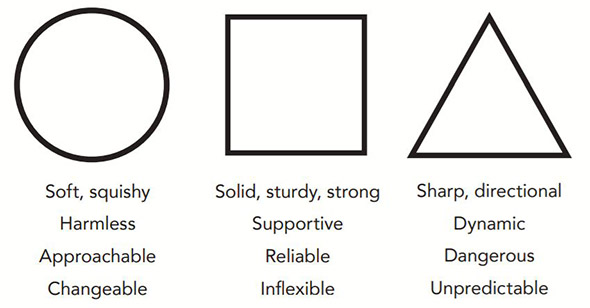
What Shape is Your Character Going to Be?
Circle: Characters who use circular shape language are usually friendly and outgoing- the kind of characters you really just want to hug. This shape is perfect for caregivers, children, and other gentle, innocent characters.

Square: Square shape language is great for strong, dependable, and confident characters. The cool thing about this shape is that it can be used to create really intimidating characters or very comforting ones depending on how you use it. You will often find squares used in characters such as heroes, fathers, and other characters with similar paternal roles.
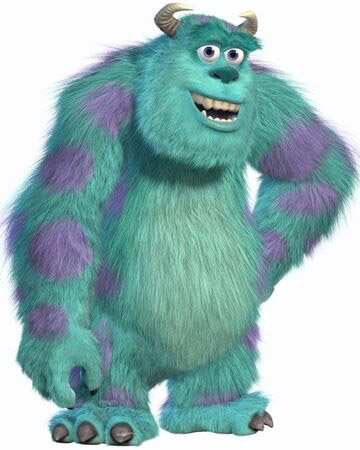
Triangle: Well-known as the evil shape, triangles are usually used in the designs of antagonist characters. Triangular shape-language can look quite aggressive which is why these characters are often considered to be sinister and unpredictable. It is important to note, that the more stretched the triangular shapes the more menacing your character will look!
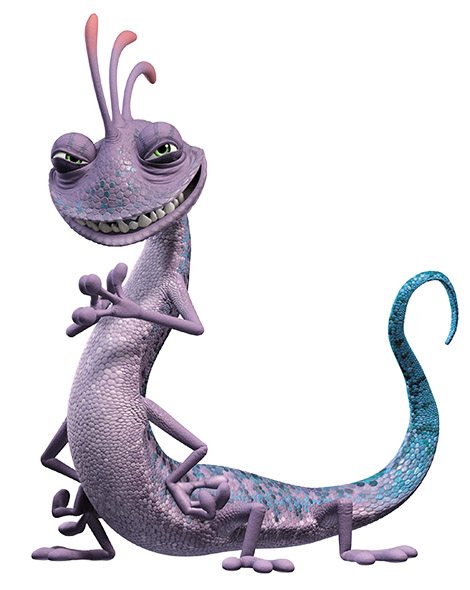
Note: Your character does not have to include only one of the three shapes! More complex characters will often be a combination of the two shapes they most represent! For example, your character may be both strong and kind, or evil and confident.
Good vs. Bad Character Design
There are a lot of different factors that contribute to the effectiveness of a character design. Here are a few character design tips to help you create good character designs every time!
First up, let’s talk about thumbnailing. When you first design a character, it is super important that you create multiple different iterations. These should be small sketches and are usually referred to as design thumbnails.
Creating multiple sketches of your character allows you to fine-tune your design as it helps you identify the most effective elements in each iteration.
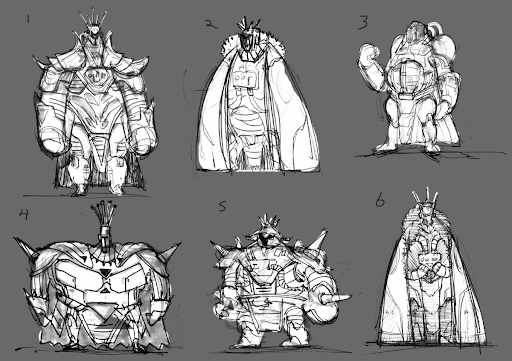
This process is something that a lot of professional character designers use to improve their work. As you can see in these concept art thumbnails of ‘Obsidian’ by concept artist Andrew Erickson, thumbnailing is an awesome technique for testing out a range of ideas for your design.
What are You Trying to Say With Your Design?
When creating memorable characters it is super important to think about what you are trying to communicate with your design. A few factors you will need to consider are character exaggeration, costume, and props.
Exaggeration:
If you want your characters to have a strong and lasting impression on their audience it is important to utilise exaggeration in your designs. Consider what parts of your character can be emphasized and which parts can be simplified to best convey their personalities.
A good character design is one that can be transferred into a very simplistic style and still be identifiable- examples of this include the designs of most popular superheroes- which have easily readable features no matter the style they are drawn in!
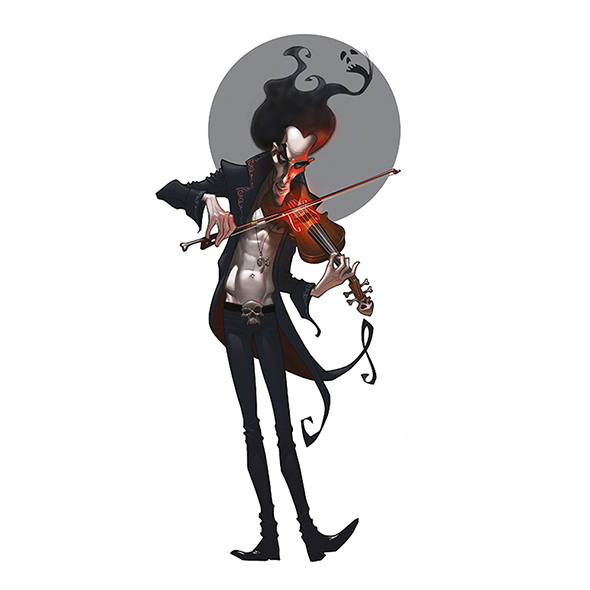
To decide which parts of your character to exaggerate try identifying the primary traits of their personality and storyline. Maybe your character is a shy and really good listener so they have big ears and a smaller mouth.
Or perhaps your character is going on a journey but they are anxious and try to over-prepare, so they have a comically large back-pack. The possibilities of exaggerated features are nearly endless and depend completely on what you want to emphasize about your character.
A good way to work on building your exaggeration skills is to practice creating caricature-style drawings from real-life references. ‘Drawing Caricatures’ by LoopyDave is a great resource for those looking to give this a try!
Costume and Props
A character’s costume and props can be vital to the effectiveness of your design. A good character design is one with a well-considered costume that heavily reflects both their personality and context.
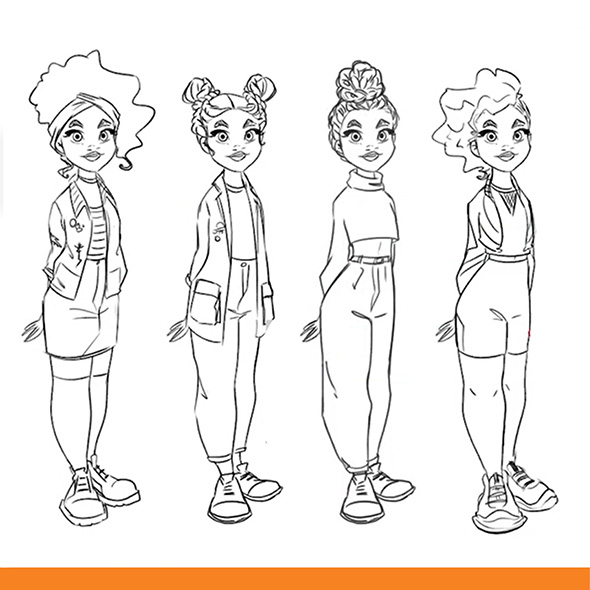
Before you even start designing your character’s clothing, first do some research into where they live and the type of activities your character will need to perform. A good costume will be functional within the character’s setting.
This can be a bit tricky when you are just starting out. Luckily, ‘Digital Illustration for Beginners’ by Laia Lopez, will provide you with the perfect introduction to costume design for characters!
Ask yourself questions like: Do they live in a cold climate? Do they require any special clothing or props to live there? Are their clothes suitable for their occupation? Etc. Once you have researched all these factors you will be able to move on to adding some personality to the costume design.
What colours does your character like? What do they represent about the character? The colours, patterns, textures, and shapes you use in your character’s clothing have the potential to communicate a lot about your character.
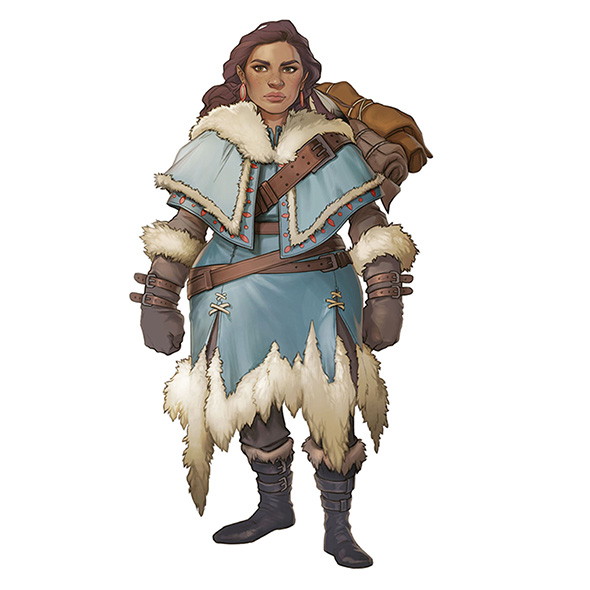
Know Your Character
Personality
When you create characters it is important to consider what your character’s overall disposition will be. To decide on this, think about what type of behaviors your character would default to on an average day. Are they shy, confident, brave, outgoing, lazy, hard-working, or any other basic overall personality you can think of? Understanding your character’s personality will help you choose better poses and expressions when illustrating!
Emotion
While personality is static, a character’s emotions can always change. This is something that should be represented in your designs. For example, a character who is usually confident will still have moments when they are feeling shy, depending on their circumstances.
Each character will express their emotions differently, so it’s important to consider this when you are choosing facial expressions!
Desire
Just like any real person, your characters should have things that they really want to obtain or achieve. These desires will make them much more interesting for your audience, as they give your characters something to work towards!
A character’s desires will determine what actions they are likely to perform, making it a lot easier to choose key poses to illustrate your character.
To learn loads more about creating emotive characters with well-defined personalities, check out ‘Creating Expressive Characters’ by character designer Kenneth Anderson!
What are the Main Differences Between Designing Male & Female Characters?
When designing your characters it is helpful to understand some of the key differences between male and female proportions and shape language.
A good way to gain an understanding of these differences is to frequently study photographic or real-life references. Though everyone’s proportions are totally unique to themselves and not everyone fits under these gender categories, there are a few basic rules you can apply to your work to make your characters appear more masculine or feminine.
Masculine vs Feminine Faces
When it comes to illustrating faces, there are a few key differences between masculine and feminine faces. When compared to a females face, a male face will tend to have:
Compared to masculine faces, females generally have:
Masculine vs Feminine Body Structure
Due to varying hormone levels, men and women are going to have different body compositions. Especially when it comes to where we are likely to hold fat and how we gain muscle. Some important things to note when it comes to this are:
It is important to note, that due to the awesome diversity of human genetics worldwide, not many men and women will fit every one of these rules. This is great news! It means once you get a general understanding of these features, you can choose which of these masculine and feminine traits best fit your character designs!
Are you Choosing the Right Poses for Your characters?
Posing your characters correctly can be one of the most important parts of the design process. Your character’s pose can communicate a lot about their personality to your audience!
Gesture Drawing
The first step towards creating amazing character poses is gesture drawing! Practicing gesture drawing from life references, movies, or photographs is a great way to make your character poses more dynamic. Here at 21 Draw, we have an awesome course that will teach you all about ‘Gesture Drawing’ and how to grow your pose drawing skills!
Some gesture drawing tips to get you started:
What does your pose say about your character?
The pose you choose for your character can communicate a lot about their personality, emotions, and desires.
For example, using a concave (c-shaped,) line of action for your character’s pose can help them seem timid or sad, whereas a convex curve can be used to make them seem more confident or happy.
So, before you choose your pose, think about what you want to say about your character and how you can best illustrate this information through curves, tilts, and expressions!

There are so many different ways you can alter your character’s pose to make it more effective. If you are interested in improving your posing, Tony Bancroft has an amazing course on ‘Drawing Character Poses with Personality’ that I highly recommend checking out!
Creating a pose with a readable silhouette!
Once you have got your design nailed down, you can start thinking about how you will pose your character. An easy way to check whether or not your pose is working is to create a silhouette of the pose and see if it still reads well. Good poses are easily understandable even when silhouetted!
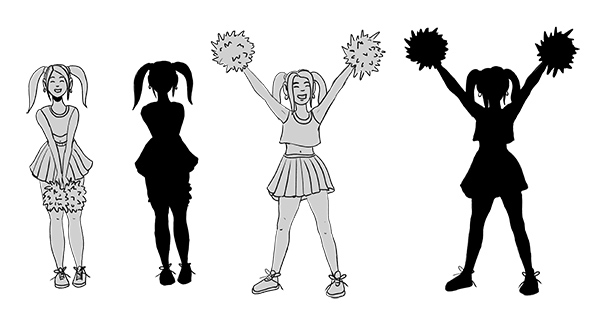
As you can see with the pose on the left, when the character’s pose is silhouetted her cheerleading pom-poms and most of her costume are obscured due to the posing, making it difficult to gain an insight into her character.
However, in the right-hand pose, her action and design remain clear even when silhouetted – communicating a lot more information about the character to the viewer.
By making strong posing choices for your characters you will greatly improve the readability of your character designs!
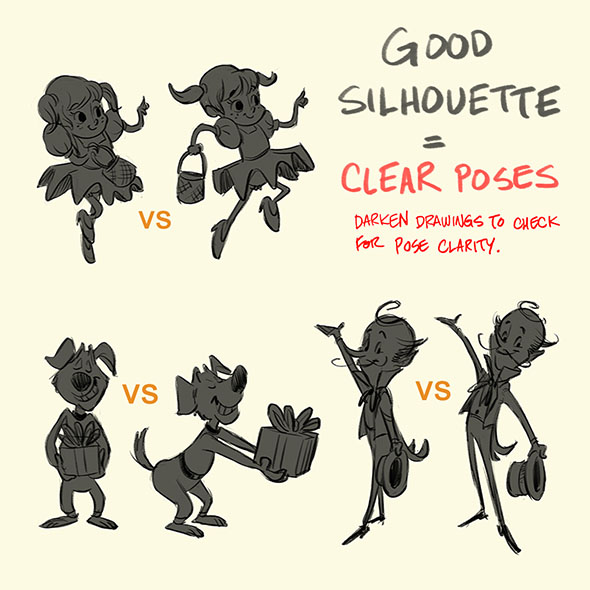
Find a fresh perspective!
Have you ever worked on a piece for so long that you can’t really tell if there are mistakes anymore? It can be really difficult to see errors in your own work, so it is really important to seek out feedback!
For a lot of beginners, this feedback will come from their teachers. However, if you aren’t studying there are still a few places you can get feedback including asking friends, family, or even other artists online! There are tons of lovely artists on social media that will be happy to help you out if you ask!
How to Choose Your Colour Scheme
Once you have your character design finalised, you will be ready to start thinking about what colours you want to use in your illustration.
The colours you choose for your character can dictate a lot about what type of character they are as well as how they will stand out against their intended environment. To help make this decision easier you may wish to choose a specific colour scheme for your design.
Talented artist Meike Schneider has amazing lessons on colour theory in her course ‘Drawing a Female Character’ that will really help you understand these colour combinations!
Here are a few of the awesome colour schemes you may wish to try out!
Complementary Colours
Complementary colours are the exact opposite of each other on the colour wheel. This gives a highly contrasting, bold look. If you want your character to stand out, a complementary colour scheme is perfect!
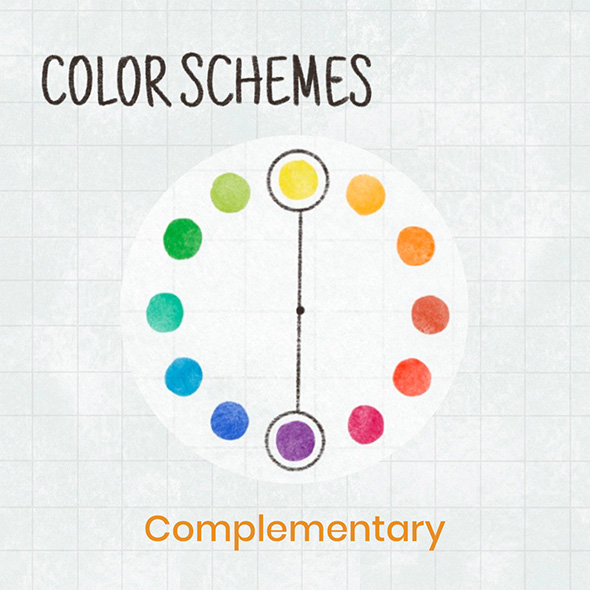
As you can see in the below example, the use of complementary colours for a character design really allows for the details to pop in the illustration! This can be a useful tool when you are creating a protagonist who needs to be the focus of your drawing.
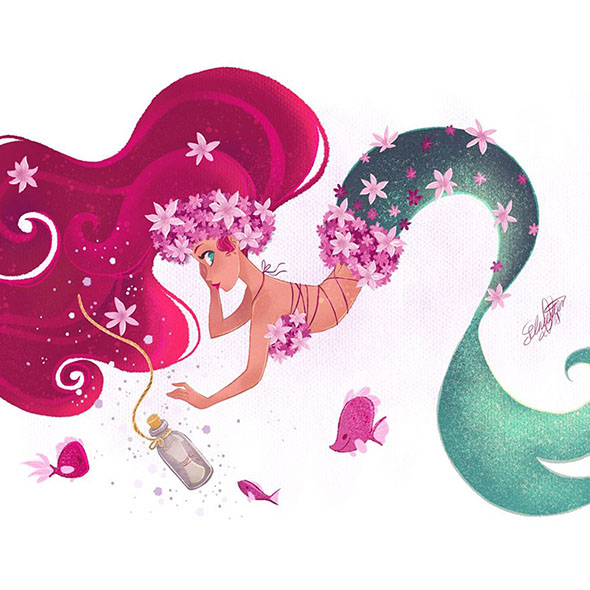
Monochromatic Colours
A monochromatic colour scheme uses only the tones, tints, and shades from a single hue on the colour wheel. This creates a really unique and often emotive look in an illustration. If you are looking to make relatively simple colour choices, this could be the best method for you!
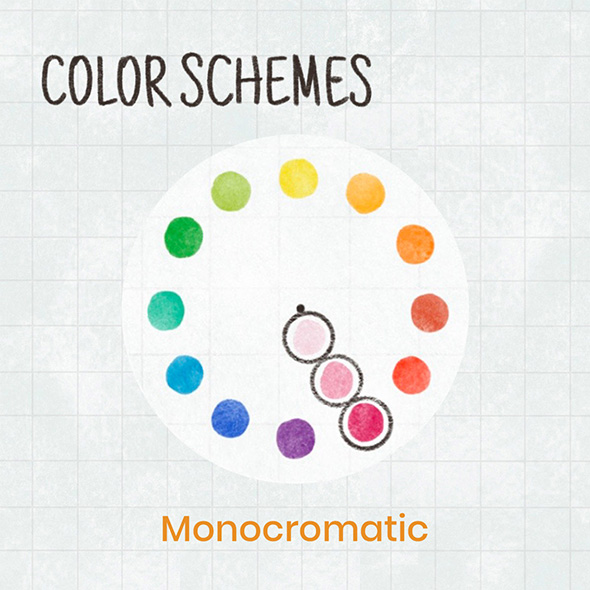
This colour scheme is great for creating characters with well-defined traits that may be best expressed through a specific colour. If you have a very complex character design, monochromatic colours can also help simplify their appearance and make it more visually appealing.
A monochromatic color scheme is also a great choice if you are looking to improve your understanding of values when colouring and shading your work!
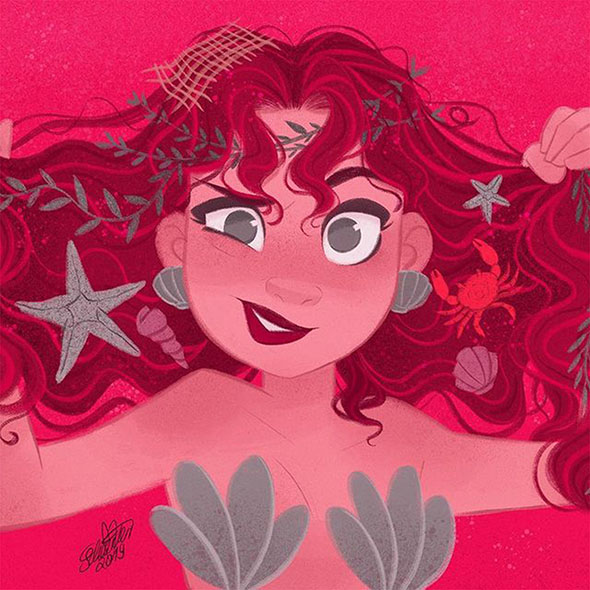
Triadic Colours
If you are looking to have a bit more variation in your colour scheme, the Triadic method might be just what you need! These colour combinations use 3 colours that are equally spaced apart on the colour wheel.
When it comes to using triadic colours, it is best to choose one of the three to be the most prominent in your illustrations and use the other 2 for highlighting smaller details.
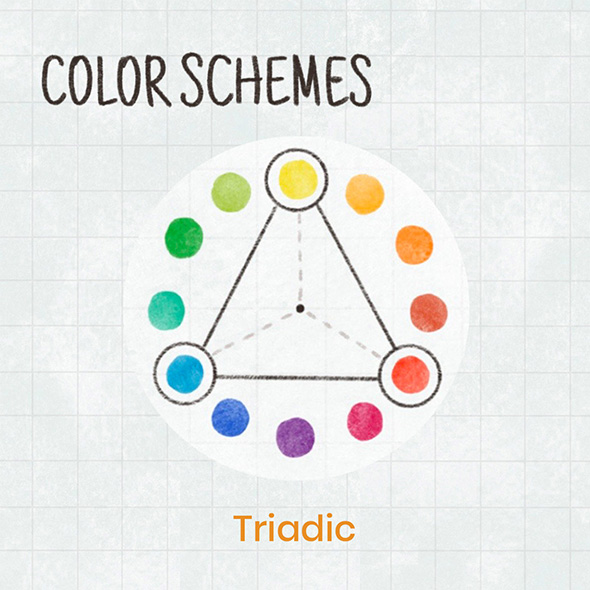
This colour scheme creates a very vibrant look, even when the colours are toned down. It is best used for characters with playful energy, as these colour combinations can often feel very youthful. This makes triadic colours perfect for characters aimed at a younger audience!
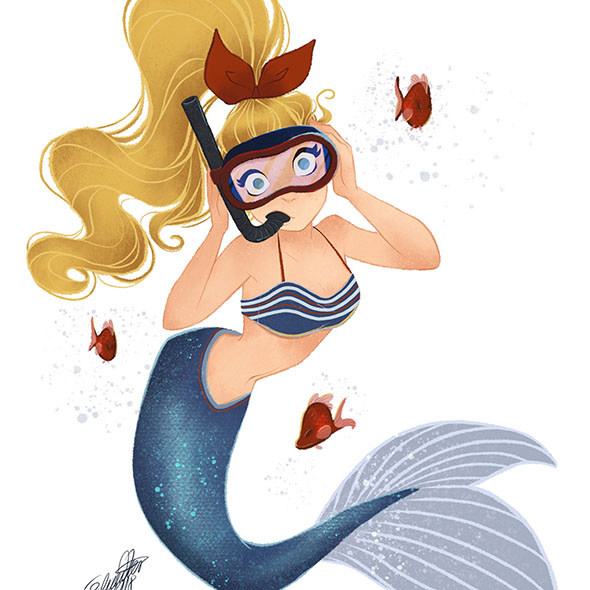
Warm VS Cool Colors
When it comes to using warm vs cool colours there are a few key things to consider. When added to an illustration, warm coloured objects will typically feel closer to the viewer, whereas cooler ones will feel further away.
This is because of atmospheric perspective, which is essentially just the effect of particles in the atmosphere making things further away have a bluish tint.
The colour temperature of your characters will have a similar effect, for example, warmer-coloured characters will stand out and feel confident, whereas cooler-toned characters may appear more closed off and mysterious.
However, just like anything else in art, these rules can be broken if you feel like experimenting to create more unexpected designs!
Methods for Adding Colour to Your Design
There are two main ways that artists add colour to their illustrations. The first, probably the most obvious method, is to start right away with colour or underneath your line art. This method is great for when you already know which colours you want to use and it gives a similar feel to traditional colouring or painting.
However, another colouring option is to first digitally paint your character in greyscale before using a range of colour blending layers to finalise the look of your piece.
This method allows you to experiment more with the colours in your design, whilst still achieving the correct values in your shading. If you are currently trying to improve your lighting and shading skills, I really recommend giving this method a go!co
So, now that you have all these awesome character design tips, are you ready to start creating your own characters?
If you want to learn EVEN MORE you can find the awesome courses mentioned in this post here!
Rhea is an Australian concept artist who is currently studying at Griffith University. She is passionate about spreading her love of art to others.
Character Design – Everything You Need to Know
2D and 3D animation have produced some of the most iconic characters in television and film. However, these characters must first be designed before they can be animated.
Iconic characters are more than just well-drawn figures. They are given personalities and details that make them memorable and enable them to tell stories. The purpose of character design is to achieve this. This article will look at why character design is important, what constitutes a great character design, and what the character design process comprises.

What is Character Design?
Character design is a technique for creating characters for animated films, comics, toys, advertisements, and publications. First, let’s look at the character design definition to understand better what the character designers are trying to accomplish.
Character design is the process of fully developing a character’s style, personality, behavior, and overall visual appearance in the visual arts. Character designers construct characters as a means of conveying stories. This means that every detail of a character, such as shapes, color palettes, and details, has been carefully chosen.
The aesthetic qualities of a character are frequently influenced by the details of a character’s personality. Thus, color theory, shape language, and even fundamental psychology can aid in the creation of a successful character design.
Key Elements of a Character Design
The Aim of Character Design
The story is at the heart of all video games, animated television series, and films. Character is at the heart of all stories. These characters should be interesting, aesthetically exciting, and memorable, according to character design. Artists in the visual arts and animation can design characters from the ground up. This enables them to make use of every facet of design to establish a distinct personality.
Features of Good Character Design
It is all about clarity when it comes to character design. This entails a captivating design and one that is distinct regardless of how we view the character. The three elements of good character design are as follows.
Silhouette
A character silhouette remains after all colors and details have been removed. The contour of the character shape has been filled with black. You can use a character’s silhouette to identify them, which indicates effective character design. Take a look at the outlines below. How many characters can you identify solely by looking at their silhouette?
The silhouettes of a couple of these characters are easily identifiable. Yes, many of these characters have become famous, but it is due to solid, apparent character design.
It is critical to have a thorough understanding of shape language while constructing a distinct character silhouette. Learn more about the language of forms and how they contribute to successful character design in the video below.
Palette
The usage of color by a character designer is referred to as a palette. Selectivity is crucial when it comes to color. The last thing you want is a character with a kaleidoscope of hues with no hierarchy or purposeful palette utilization. This will end up distracting rather than engaging the audience.
It is crucial to make one color the primary color of a character and utilize additional colors to support that color as much as possible. Instead of competing with each other, try to use colors that complement each other. Check out the video below on color theory in movies to learn more about the impact of different color palettes.
It is tempting to get carried away with color while designing a character, generating colorful and complicated color palettes. However, keep in mind that the simpler your color palette is, the better.
Exaggeration
Exaggeration is likely the most significant of the three main components of character design in terms of storytelling. Exaggeration is the deliberate use of specific features to provoke emotional and psychological responses from a character’s audience. For example, these exaggerated features might make the difference between a character art as heroic or scary by an audience.
Exaggeration is the ultimate storytelling technique in character design, as explained in this video by BaM Animation.
Character design relies on three key elements: silhouette, palette, and exaggeration. While a character designer must consider many things, these three are frequently at the heart of making a character design memorable or entirely unforgettable.
The Process of Character Design
Let’s look at the basics of the character design process now that you understand the objective of character design and the critical components of successful character design.
Research
When it comes to character design, references are vital. Before even beginning to sketch, the artist must conduct extensive research on the actual object, depending on the character they create. For instance, suppose you want to make an animal character. Whether it is a hedgehog, a sphynx cat, or an eagle, you may learn more about it by viewing a documentary, reading about it, and searching for photographs on Google. This way, your research not only provides you with a thorough understanding of how these creatures act, walk, and what distinguishes them from one another but also immerses you in the subject.
Target Audience
Crucially, your design will be influenced by your target audience’s experiences. Before you do anything else, figure out who the character is trying to reach out to. This will be the foundation for the design. Knowing your audience will help you decide how the character should seem, including the colors to employ and the mood to establish. A client’s brief will usually include audience statistics. Still, you will want to go beyond demographics like age, gender, and geography to find out more. Look into other artists who create for that target group, as well as the styles they like.
Gather Reference Images
This leads us to our primary research method: collecting reference photographs or searching the internet for photos and artwork related to your subject. It is critical to recognize that referring to photos for inspiration is not cheating. Whether you like it or not, everything you have seen, including other artists who have inspired you, has an unconscious influence on your work. Collecting references is one way to regulate that influence deliberately. Additionally, looking into other artists who have worked on similar themes or designs for similar audiences will help you identify expectations and how your character differs.
Characters who are exaggerated, cartoony, or eccentric are not prohibited. However, it would help if you put in more effort to base them on realistic features that people would recognize. Anatomy is also an essential factor to consider. Even if you do not intend to animate the character, their position will suggest physicality. You should be aware of how they move and distribute their weight.
A good character is both recognized and distinct. Look at photographs of giraffes if you need to sketch one- What are the proportions, what body shapes are there, how do the legs work, and how does the character move? The more variants of these recognizable traits and conditions you sketch and draw, the easier it will be to abstract and create your character.
Define the Character
When it comes to character design, these suggestions can help artists think about their character and the characteristics they want their character to have before sketching up a design.
Conceptualization
Character design is a type of illustration known as concept art. It’s all about expressing the artist’s idea for how a character might seem in the future, whether in a film, video game, or company website. Before spending enormous amounts of money on production, the entertainment business employs concept art to depict its ideas. An ideal character design should sell the vision to that objective.
Origin of the Character
When creating a character, it is suggested to examine the century or location. This is a crucial step since it establishes the tone for the character’s future environment and backdrop.
A fully armored knight, for example, would be appropriate for a Renaissance fortress. A space marine in full battle gear would be suitable for a future space battle. Consider the period: the style of clothes and personality in the 1980s is substantially different from that in the 1920s.
Name and Look of the Character
It is time to construct some baseline statistics after you have decided on a period and area. The list below is an excellent place to start, but designers should not limit themselves to only these differentiators. Any person who has played a role-playing tabletop game can imagine the various stats they need to describe.
Redeeming Characteristics
Every character has a redeeming quality about them; a nice and positive quality. For example, it could be that their nature is kind, passionate, charming, loyal, patient, or any other quality that you consider a “positive!”
Fundamental Flaw of the Character
All of this says that every well-written character has a core flaw. Something in them that is not so great or even harmful, something with which they will fight throughout their journey. This can range from a nasty or mean-spirited attitude to developed insecurities, impulsive theft, and so on.
The Motivation of the Character
Last but not least, consider the character’s motivation. What brings them here? What kind of adventure do they want to take, and why? Perhaps it is a star-crossed lover on a mission to save their companion. Or a knight tasked with slaying a demon dragon to save their hometown. Maybe it is a space explorer looking for the next viable planet for human life.
Tools for the Character
There is a case to be made that the tools you use are not all that important. In theory, you can create a character just as well using pen and paper as a computer. However, even the best tools won’t mask bad ideas or a lack of art foundations.
The tools you employ are determined mainly by your desired style, personal choice, and the file type needs of the customer. For example, some painting techniques, such as watercolor, can be reproduced on a computer, although they usually look best when created in their original medium. Personal preference, of course, is based on your own artistic experience.
Finally, your decision should be based on the client’s preferred image file type. Most clients nowadays prefer a digital file for storing and sharing conveniently, usually a source file from a program like Photoshop and a primary image type like JPEG.
While the client’s decision determines the format of your final design product, you can use any tool you like before that. Many of the character painters we spoke with, for example, prefer to draw preliminary sketches on paper.
Breathe Life into the Character
Preparation
Character designers must study and prepare before drawing any lines. A thorough study of anatomy, shape language, psychology, color theory, and the story is essential for this training. This video on anatomical shape language is one of many resources available to new character designers looking to improve their skills.
Understanding the fundamental principles that go into excellent character design is preparation. The real magic, however, happens when these principles are put into reality.
Writing a Prompt
It can be challenging to develop a unique and memorable character from scratch. There are a plethora of options to examine. The tale is always the starting point for a great character designer. Consider composing a prompt to help you focus on a character’s role in the plot.
A prompt will provide you with a clear, specific route in which to take a character. For example, look at the video below on how a prompt might lead to a clear and compelling character design.
Anatomy of a Character
It may seem obvious, but knowing human anatomy is essential for anyone who wants to construct an accurate 3D model. The same caution should be used when employing animals or other objects as characters. Basic anatomy things to include are bone construction, which is essential because the human body has over 206 bones.
The following are the main pieces that character designers should be familiar with:
Head: The forehead, eyes, nose, ears, lips, mouth, and jaw.
Torso: Ribcage, hips, and stomach’s soft “twistable” portion, among other things.
Arms: Shoulders, upper arm, elbow, and lower arm
Hands: Wrist bone, palm, and Fingers .
Legs: upper leg, lower leg, and knee
Foot: Heel, midfoot, and toes.
Style
In terms of style, your character should be appropriate for the project. In brief, whether it is for a video, animation, or website, it should not look foreign amid its surroundings or universe. Choose a style that is appropriate for your project. It could be flat, detailed, semi-realistic, or something else entirely.
What does your character add to the tale or project, and how does he fit in? Is your character a shopkeeper, a client, a teacher, or something else entirely? Is he intelligent, cheerful, formal, or goofy? The general atmosphere is also something that you should consider in the design.
Poses
Designers may want to experiment with different physical poses their characters might find themselves when practicing drawing them. Experimenting with different facial expressions, action shots, fighting stances, and other aspects of the character’s personality is a terrific method to discover and define who they are and how they conduct themselves. Breaking down a drawing into basic shapes is the key to creating poses. Consider it a deconstruction of the previously discussed anatomical landmarks.
Gather Resources and References
Inspiration is necessary for all forms of creativity. To get character design ideas going, gather a variety of references from numerous sources. These can be from any medium, including animation, photography, film, comic books, and paintings. As they move on to the following phase, developing a thumbnail, many character designers have their favorite sources on hand.
Construct a Thumbnail
Making a thumbnail is the initial step in putting a character designer’s ideas on paper (physical or digital). This is a safe environment where artists can explore and make scribbles to get a sense of what direction they want to go in.
Thumbnails can be approached in a variety of ways. Beginning with silhouettes is a frequent and effective strategy. Character designers can use silhouettes to create a blueprint that can be iterated on with further depth. This and other thumbnail tricks are demonstrated in the video below by Kimby Arting.
Finalize Details and Linework
Artists begin finalizing the character design once they are satisfied with their thumbnails and sketches. Character designs are fleshed out and taken to thoroughly condition the character by adding linework, color, and detail. Refinement is a common theme in character design. This does not always imply adding to a character’s design but instead improving it. It’s never easy to come up with a character. After all, character designers create a fully-realized personality with distinct aesthetic features from thin air. Character design is a very deliberate process that involves both art and storytelling prowess. Try to focus on what makes a great character design unique and the choices a character designer draws to make it the next time you see one.
Drawing the Character
There are many ways to succeed in everything, but here are a few steps a designer can take when starting to sketch their character.
First Step: Break the drawing down into basic shapes and lines.
Use a sphere for the chest and head, a cube for the hips, a triangle for the chin and feet, lines for every limb and finger.
Second Step: Include the anatomy.
The next step is to add body landmarks to your sketch. This stage expands on the previous drawing layer while remaining loose and exploratory.
Third Step: Fill in the blanks with information about your character.
Now is the moment to flesh out the character’s personality and investigate the aspects of creative design.
Designing the Character
It is crucial to determine who a character is and how the viewers should feel before developing their appearance.
Character Traits: When it comes to character traits, it is a good idea for designers to jot down 3 to 5 adjectives that sum up what they want the audience to feel when they see the character.
Showcasing the Traits: Now is the time to consider and develop ways for the character’s aesthetics to represent who they are.
Eyes: “Eyes are the gateway to the soul,” as the saying goes, and the form of a person’s eyes can reveal a lot about them. A furious soul is represented by a furrowed forehead, whereas pronounced laugh lines represent a joyous spirit. Eyebrow forms can tell a lot about a person’s personality.
Jawline: A character with a strong jawline might convey to the viewer that they are aggressive, rugged, and confident. Softer jawlines, on the other hand, express feelings of youth and friendliness.
Nose Shape: Characters’ noses come in a variety of shapes and sizes. A nose that is hooked or crooked suggests a secret background or a malicious schemer. Characters with small button noses are charming, childlike, and innocent. Strong, angular noses are ideal for characters who are self-assured or tough.
Ears: Ears can depict otherworldly creatures such as elves or orcs. They can also be adorned with jewelry that reveals information about the wearer. For example, someone who wears magnificent traditional earrings could be a member of royalty. On the other side, rough metalwork earrings could be worn by characters who are more misunderstood.
Shape Theory
Circles, squares, and triangles are the three fundamental shapes that you can use to design characters. To the subconscious mind, each form has a meaning. This shape language runs throughout the figure, from the character’s basic body shapes to details like their eyes or ears.
Circles: Characters with the words soft, sweet, kind, gentle, open, accessible, honest, caring, young, innocent, unsuspecting, unsure, worldly, nature-driven, etc., can be represented by circles.
Squares: Strong, confident, trustworthy, cocky, boisterous, action-oriented, driven, forceful, devoted, arrogant, dependable, even-tempered characters can all be represented by squares.
Triangles: Triangles can be used for villains, but you can also use them for people who are quick, calculating, clever, hot-headed, rogue-like, stealthy, emotional, loving, quick-thinker, slick, graceful, and so on.
Start Designing in 3D
Character designers now have a reference library, have understood the fundamentals of design theory, and have studied the fundamentals of sculpting. Therefore it is time to consider producing the character’s concept art.
Cartoon Network is credited with giving some of the most iconic characters to the entertainment industry. Image Source: Twitter
Model Sheets
A model sheet is also known as a character board, character sheet, character study, or simply a study in the visual arts. It is a document used to assist and standardize a character’s appearance, poses, and movements in mediums such as animation, comics, and video games. When numerous artists create an animated film, game, or comic, model sheets are required to help preserve character continuity from scene to scene. A single animator may only work on one of the hundreds of shots necessary to finish a feature film in animation. An off-model refers to a character who is not drawn according to the production’s standardized model.
Purpose
In the past, model sheets were also employed to maintain visual continuity for long-running cartoon productions of short features, such as the Looney Tunes or Merrie Melodies series. Model sheets are posed cartoon or comic strip characters. They serve as a reference template for several artists working on a long or multiple-edition work of art such as a comic book, animated film, or television series. Model sheets often show the character’s head and body from various angles and sketches of the character’s hands and feet and various fundamental facial expressions.
Model sheets ensure that, despite the efforts of several or more artists, their work is cohesive, as if a single artist did the drawings. They depict the structure, proportions, clothes, and body language of the character. To show a character’s deeper emotional and physical expressions, many pages are required. Deviations from the model may be allowed in the final animation depending on the whims of the animation director. This “tightness” of the model is a crucial distinguishing feature in the overall animation style, as it represents a balance between expressiveness and smoothness/consistency. As a result, model utilization varies greatly between studios and projects. Model sheets are also helpful for making costumes and sculpted miniatures.
Specific Annotations
Model papers also include suggestions on creating specific character elements, such as their head shape, hair length and style, and the size and position of their eyes and mouth.
Examples: Some model sheets are dedicated to specific completed or continuing projects, while others are broader and cover the whole character library of a company. Aside from Disney, other animation studios and enthusiasts also offer model sheets on their websites. However, to present the notion of model sheets, Larry’s Toon Institute presents a generic model sheet.
Copyright and Fair Use
Model sheets are often copyrighted content owned by the animation studio that generated customizing rather than putting it out in the public domain. Model sheets are designed for artists who work for the studios that control the characters. These templates are created for the same purpose. Also, other artists, such as fan artists, benefit from them by customizing the characters according to their colors.
Conclusion
Character design is essential. Characters are more than just a visual depiction of a concept or a mascot that promotes a product or a study. In reality, well-crafted characters have personality and charm, which draws viewers into your style of storytelling. However, creating a likable character that will pull people in and stimulate their interest in your product, website, or presentation is a difficult task. To make it happen, character design necessitates a great deal of knowledge and ingenuity.
How to design a character: the ultimate guide to character design
When we think of some of our favorite characters, from Superman to Pikachu, design is often that last thing that comes to mind. That’s what good character design does: it hides the designer and leaves behind only a memorable character. But great characters don’t come from nothing—they are the result of planning, visual storytelling, choices and artistic skill.
For this reason, character design can be harder than it at first appears. The design has to evoke who the character is and that means the designer must be skilled at using nonverbal, visual elements such as expression, gesture, color and clothing to communicate personality traits. This is especially true for simplistic character styles, where the designer has to communicate more with less.
You may also have to make technical considerations such as whether the design can be easily animated. On top of that, there’s the question of originality and staking out your own character design style.
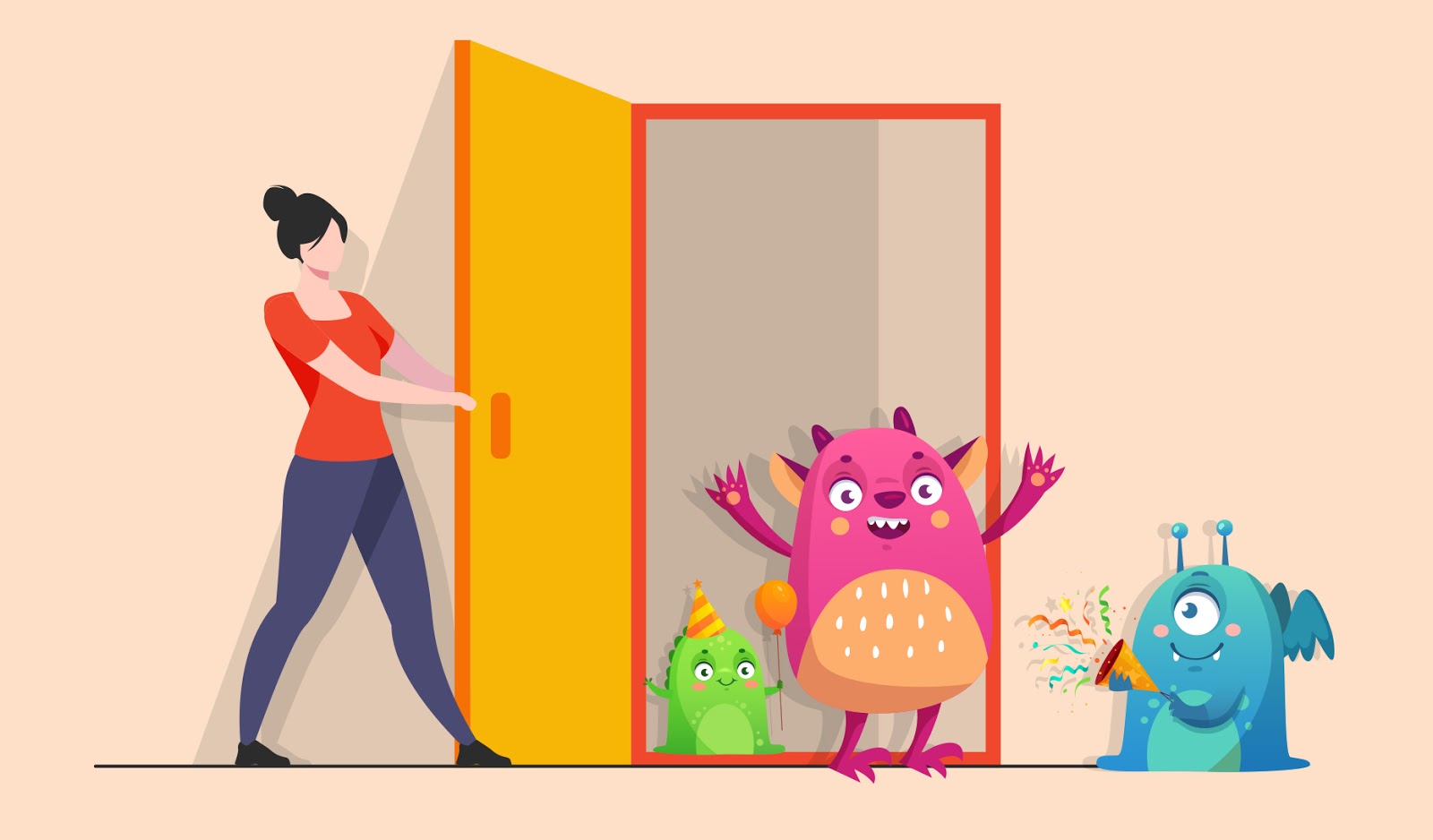
Fortunately, character design is a fairly old practice, and there are common tips and workflows that can guide aspiring designers from concept to finished artwork. With that said, every artist is going to have a different approach that works for them. With both of these factors in mind, we’ve put together this ultimate guide to character design to provide a step-by-step process and specific character design tips and advice from professional designers who are experts on our platform.
The step-by-step character design process
—
Step 1: Develop a concept
—
Character design belongs to a class of illustration called concept art. It is about communicating the artist’s vision of how a character might appear in a future context, such as a film, video game or company website. The entertainment industry uses concept art to visualize their ideas before committing exorbitant amounts of money on production. To that end, a good character design should sell the vision.
Even if you are not designing a character for any purpose other than your own portfolio, that’s all the more reason for a clear concept: your design won’t have any future context in which to explain the story behind the character.
Create a character profile
The creative brief, if you are given one, is a good place to start. The client should have provided you with information about the context for the character, the target audience, and the preferred style.
Top Level character designer Cross The Lime explains the importance of establishing a direction based on the brief, “How mainstream or quirky a character can be in branding projects really depends on the industry and client. Ask them for examples of characters they like and why.”
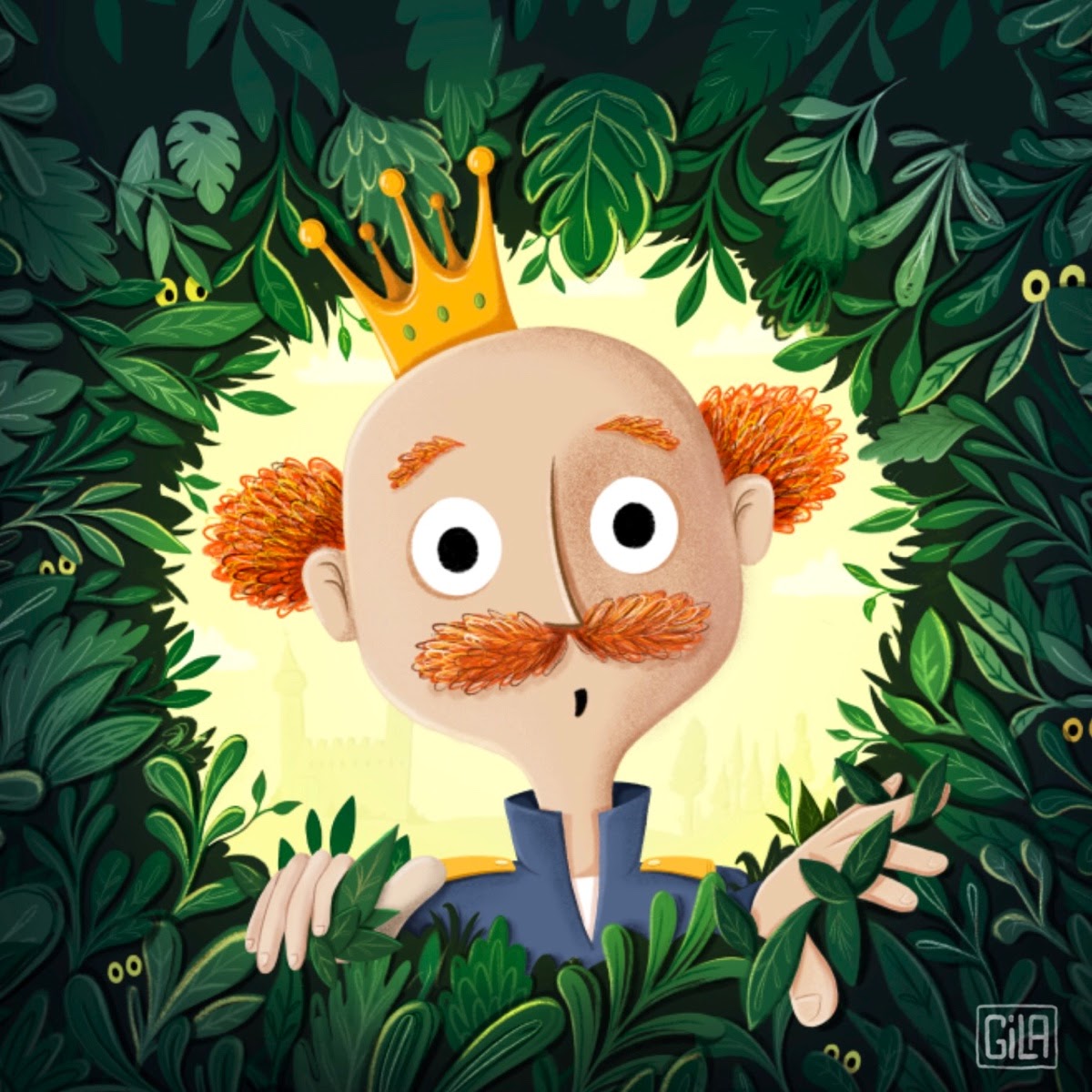
But while the client (or writer) may have already created a story for the character, that does not let the artist off the hook. Briefs are by their nature, well, brief, and it’s not uncommon for a client to have trouble expressing themselves in artistic terms.
It is often up to the illustrator to interpret the brief, ask the right questions, read between the lines, and distill the client’s explanation into core character traits. Your ideas should not contradict the brief, of course, but keep in mind that you were hired for your expertise. In many cases, the client will be expecting you to expand on the concept in novel ways that will not have occurred to them.
If you are not given a brief (perhaps even if you were), it is a good idea to essentially come up with one for yourself. You are aiming for a short prompt—no more than a paragraph or so—that gives a basic profile of the character: where they come from, what they want, what makes them special. The Five Ws can be helpful for establishing a basic premise.
At this stage, you should not get bogged down in frivolous details like if “her favorite ice cream is rocky road!”, but should aim instead for descriptions that serve as an introduction.
Brainstorm the details
There are a number of brainstorming techniques that can help you develop your character profile. One of the most helpful for character design is word association, starting with some keywords from the brief and coming up with related words that come into mind, either via mind-mapping or writing a straightforward list. The reason being that singular words keep ideas simple, distilling them to their essence, and this comes in handy when you need to communicate those traits visually.

According to Top Level designer noodlemie, “I take some time to brainstorm ideas and picture how it would look like in my mind. Before physically starting anything, I create my ‘good mood’ atmosphere by listening to music and sometimes reading comics, news or a novel.”
The character concept is a lot like the destination your ship is steering towards, and for that reason, you should pay particular attention to this step. Unfortunately, there’s not always a straightforward way to know whether you’ve chosen the right destination. Creating art is a process of blind feeling, aesthetic judgement and trial-and-error.
Get the concept as fleshed out as you can, and come back to this step later if necessary. When something in your design just doesn’t feel right, the underlying concept is usually the first place you should look.
Step 2: Do your research
—
Creating unique characters from your mind can feel like magic—so much so, that it can be easy to overlook pesky considerations like research. You might be asking, “is this a character or a term paper!?” But research and imagination go hand-in-hand. Your imagination, after all, comes from your mind, and your mind is informed by your real world knowledge and experiences.
Research the target audience
More importantly, your design will depend on the experiences of your intended audience.
“Before anything else, research the target audience to which the character aims to reach out,” Top Level character designer Maylyn describes their research process. “This will serve as the basis of the design. Knowing the audience makes it easier for you to decide how the character should look, including the colors to be used and setting the mood.”
A client will typically provide audience information in the brief, but you’ll want to do research beyond demographics such as age, gender, location, etc. Look up other artists who design for that target audience, and the types of styles that appeal to them.
Gather reference images
This brings us to our primary means of research: gathering reference images, or scouring the internet for photos and artwork relevant to your concept.
It is important to understand that using reference images for inspiration is not cheating (provided, of course, you are not creating exact copies). Whether you like it or not, your art is subconsciously influenced by what you’ve seen, including other artists that have inspired you, and collating references is how you consciously control that influence. In addition, researching the work of other artists on similar concepts or designs for similar audiences can also help you see what is common and how your character can be different.

As Top Level designer bananodromo puts it, “Gathering inspiration is necessary sometimes, maybe to understand how other successful artists make their characters awesome. Analyze and come to conclusions, but don’t imitate. Find your own path.”
Of course, other artists are simply interpreting what they see in real life in their art, and your reference material must similarly include real life photos or direct observation. As Top Level designer ananana14 so eloquently puts it, “the best tip I wish I could have given myself when starting out is that real life is the best inspiration.”
Exaggerated, cartoony or oddball characters are not excluded here—if anything, you should make more of an effort to ground them in realistic traits that people will easily recognize. An important consideration is also anatomy. Even if you are not planning to animate the character, you will imply physicality in their pose and should understand how they move and distribute their weight.

According to Cross The Lime, “A good character is recognizable, yet unique. If you need to draw a giraffe, look at photos of giraffes. What are the proportions, what shapes make up the body, how do the legs work, how does the character work when in motion? The more you sketch and draw variations of these recognizable features and shapes, the easier it is to abstract and come up with your own character.”
You can find reference material from virtually any source—Pinterest, Google images, ArtStation, Dribbble, even your own camera roll. You can also gather reference images for anything you’re unsure about—from the character concept as a whole to specific details like clothing, hairstyle, facial expression, poses and more. The important thing is that each of these images help you visualize your concept.
Top Level design team Miniverso Studio offer their perspective on this stage: “Research is the essential part in character design. Get inspired by other designs and styles that bring you closer to what you are looking for. Gather references in images, style, color, personality, expressions and more. Soak up everything that manages to give your character soul.”
How many reference images you’ll need will depend on the project and how much you feel you need to learn. That said, it should definitely be more than a few in order to get diverse perspectives. Once you’ve gathered these materials, it can be helpful to create a collage or mood board. This does not have to be anything fancy: just all of your images collected in one document that you can keep open on your computer as you work.
Step 3: Choose the best tools for your project
—
There’s an argument to be made that the tools you use don’t necessarily matter. In theory, you can design a character as effectively with pen and paper as on the computer, and likewise top tier software won’t cover up poor concepts or lacking art fundamentals.
The tools you use largely come down to your intended style, personal preference and the client’s file type requirements. Some art styles, such as watercolor, can be mimicked on the computer but usually come out best in their original medium. Personal preference, of course, depends on your own experience creating artwork.

Finally, you should base your decision on the image file type the client wants. These days, most clients will be expecting some sort of digital file for easy storage and sharing, usually an original source file from a program like Photoshop and a simple image type such as JPEG.
But while the client’s preference determines the format of your final design deliverable, you can use any tool you like before you get to that point. For example, many of the character artists we interviewed prefer doing preliminary sketches on paper.
As Top Level designer velcheva puts it, “I draw my illustrations using a laptop and a graphics tablet. Although I got used to the tablet for many years, it is still quite difficult for me to start drawing; I draw a line, delete, draw another one, delete again. But it’s much easier for me to start drawing on paper.”
Meanwhile, Cross The Lime outlines her process as; “I often draw outlines by hand, then vectorize and add color in Adobe Illustrator—it is faster for me, and has a more fluent/ organic look and constructed lines and vectors.”
As mentioned before, the analogue tools, whether inkwells or paint brushes, will depend on the style you are going for. Digital drawing tools can be more flexible, but let’s briefly go over some of the most common software for character design:
Step 4: Start with thumbnails (a lot of them)
—
You might be familiar with the term “thumbnail” from its internet usage: a tiny preview version of an image or video. In the illustration world, the idea is similar—thumbnails are small samples of images—but the purpose is different.
Thumbnail sketches allow the artist to put their ideation into practice, trying out several, small, quick drawings before committing to a single idea as noodlemie explains, “I draw some doodles or raw sketches on paper for a few options before I do the actual illustration digitally, after I look for some related references for the style or coloring”.
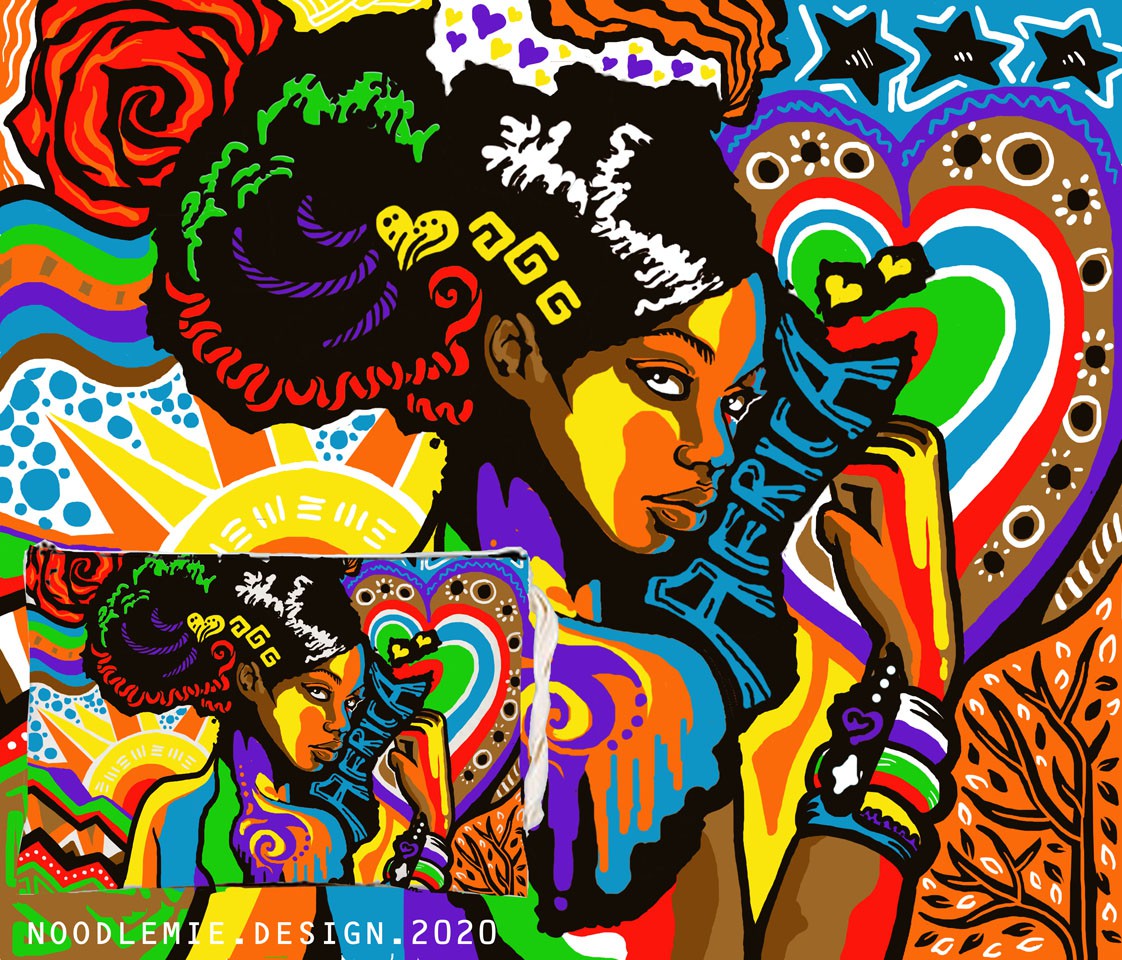
Work small and fast
There’s no specific recommended size for thumbnail sketches, but ideally they should be small enough that you can fit dozens on the same page. They should be devoid of most detail: focusing on basic shapes and gestures. The key here is variety—in terms of poses, “camera” angles, and the specific reference image you’re capturing. Sketch out as many ideas as you can think of, even if you think you found one you already like.
You should also emphasize speed and volume: aim for a minute or less for each thumbnail drawing. Working this way keeps you from getting too precious about any one particular drawing since the more time you put into a sketch, the more reluctant you will be to change things. You will also capture a sense of energy in the character pose through speedy linework.
Another of our Top Level character artists, BayuRIP, uses this phase to push the concept to new heights, “Combine some elements into the character, make it weird and unique. Try to explore shape and angle to make it different and add your personal style to the design”.
Pay attention to overall shapes and silhouettes
When you have a good number of these (in the tens, at least) a useful technique is to block in silhouettes. This means painting over the shape so that you can see whether the image reads clearly based entirely on its outline. Ask yourself, can you tell what the image is supposed to be? What are the dominant shapes? Is the pose clear?
Cross The Lime summarizes, “It is even more important that you keep a clear silhouette in mind when designing. Have ears, head shape, position of arms clearly defined, so that you can recognize the character even when it is just the silhouette.” If you have not done so, it’s a good idea to brush up on shape language. This, (in addition to color later on) is a primary visual way to communicate traits and emotions such as stability, danger, or innocence.
Step 5: Finalize your sketch
—
If you’re tired of sketching after that last step, I have good news for you!
Just kidding—it’s time for more sketching. That said, it is a good idea to take a break at this point if you have the time to spare. Doing so will allow you to clear your mind and come back to your thumbnails with a fresh perspective. When you are ready to get back to work, find the thumbnail that evokes your concept most effectively. You are then going to create a larger, more detailed sketch that will serve as the basis for your final artwork.
Miniverso Studio highlights the importance of this stage, “The digitization process of our character will be easier with a well-elaborated sketch.”
Finalize the pose and fine details
Your main concern at this stage should be the pose, so take the time to sketch a few options that show off the character’s personality. If you are designing a character for an animator, you will also need to create a handful of orthographic T-pose sketches. These display a front, back, and side view of the character standing with their legs together and arms outstretched, and they give the animator a neutral view of the design on which to animate. T-poses can also be useful for figuring out clothing detail that may get lost in a more expressive pose.
Cross The Lime advises, “As you are sketching, remember that depending on use, your character must be able to move around. Will it need to hold a sign, jump over things, or bend down? Your character’s anatomy must allow for these things. Ideally, your first character sheet has expressions along with the character turning around. What will a frontal view look like, side view, two-thirds, and maybe even from behind.”
Besides the pose, you should be paying particular attention to details like facial expression, hand gestures, and clothing folds in order to get the design as far along as you can. “The facial expression, especially the eyes, significantly defines the mood of the character,” Maylyn explains. “The posture and colors make the character pop out. So, everything needs to complement each other to make your character alive and believable.”

Gather feedback before proceeding
If you are working on a team or with a client, this can be a good time to gather feedback before going any further—in which case, you may want to provide a few (no more than three) options. The purpose of this sketch is to guide your final artwork, so it is going to get harder to make any big changes to the design from here on.
Step 6: Render your character design
—
In a lot of ways, you have already successfully designed a character by this point. Design is less about illustrative flair and more about choices, creating the concept, and the bulk of that hard work is behind you. Now is where you start the render process, which is a fine art way of saying going from sketch to finished artwork. That, of course, is not to say that you should pay less attention to the render. In order for your character concept to land, it has to be truly presentable. In addition, you may notice details that you need to change the more realistic your design becomes.
Digitize the sketch
If you’ve been working on paper up until now, you will first need to digitize your sketch. You can do so fairly easily these days using a smartphone, as velcheva tells us, “I take pictures with my phone and send a personal message to myself in any messenger that is also installed on my laptop (this is much faster than scanning). I take a photo of this sketch, make it a translucent layer and draw over it in a graphics editor.”
Be sure also to convert the image to black-and-white and adjust the contrast to really help the linework come through. It can also be helpful to trace a clean, digital sketch on top of this one using your brush tool or you may want to jump into inking if your character will include inked, cartoon lines. Finally, be sure to turn down the opacity on your sketch so that you can draw over it.
If you are sticking with physical artwork, you can use tracing paper to transfer a clean version of your sketch onto your canvas. From there, you simple render from the colors and materials of your preference.
Focus on value
Most artists recommend starting your render with a focus on value. Value is an art term that refers to light and shadow, and as this can be a challenge in and of itself, it is best to separate value from color.

To block in value, you’ll want to choose contrasting shades of grey for shadows, mid-tones, and highlights. Working in a separate layer beneath your sketch, color over your character with the mid-tone. Next, decide from what angle your light source is coming (don’t forget secondary sources such as the light reflecting off of the floor back onto the character), and block in the general area for shadows and highlights on the character.
If you are going for a more painterly style, you can blend these tones by using a brush with a lowered opacity and sampling new grey tones periodically using the eyedropper tool. Otherwise, most cartoonish styles tend to keep the hard edges for their colors and shading. To get an idea of how all this is done, search for and study process videos from other character artists on YouTube.
Add color
When you get to the coloring stage, Miniverso Studio offer sound advice, “the ‘for fun’ final stage has arrived! Play your favorite song and look for the most welcoming place; in this phase, the final artwork is the reward for your hard work”.

For colors, you should aim to choose those that contribute to the character’s overall mood and story but that are also realistic. A firm grasp on color theory and color psychology as well as learning from the colors in your reference images all can help you identify the ideal color palette.
Working non-destructively in a separate color layer will also allow you to experiment. When you’re ready to paint in your colors, use a blend mode such as “Color” in Photoshop in order to tint your value tones with the appropriate color.
Step 7: Add the finishing touches
—
No character lives in a vacuum. Well, technically Galactus lives in outer space, but for everybody else, it is important to create a sense of environment for an effective presentation.
Decide on a background
Generally, building a detailed background with scenery and props is not only a lot of extra work, it can distract focus from the character.
One option instead is to suggest a distant, out-of-focus background with roughly painted shapes behind the character. But most artists opt for a fairly simple background, often in a neutral greyish tone with a subtle color gradient or texture. The colors you choose can further enhance the intended mood of the character. Adding a floor shadow as well is a simple way to ground your character in space and reinforce the lighting.
Put together a presentation
Additionally, you are going to want to put together a client presentation. These presentations often include a variety of secondary poses (including neutral ones), outfits, facial expressions, and close ups and side profiles of the face.
These variations can be much simpler than the main action pose since that design should be the focus. Some artists like to show a few of the sketches and thumbnails so that the client can appreciate the development of the concept. Doing so not only gives the client options, it creates the sense that this character is alive rather than a doll pinned down to a static pose.
Of course, before you send your presentation off to your client, it’s a good idea to take a step back and evaluate honestly how you yourself respond to the finished character.
“Ask yourself: Does this character make you giggle? In my case, a huuuge component of my work is the comedy factor,” artist bananodromo describes her process. “I love silly details, grotesque expressions, surrealism, surprise effect. Of course, this doesn’t apply to all projects […] but mainly for the most creative ones.”

4 final tips on character design
—
Character design might look like artistic magic, but it actually involves thought, experimentation and hard work to get a successful result. While the steps we’ve laid out here can help give you a starting framework to develop your character designs, it takes time and practice to hone your skill as a character artist.
To that end, we’ll leave you with some final words of advice from experienced character artists to help you along your journey:
1. Explore what you like, advises InQueen: “If you want to be a character designer, here is my advice: first of all, I think you have to be realistic and know what you are good at and what you are not. Try everything and see what you like. What do you really like that makes your heart burn? I love my job, and I know it doesn’t suit everyone. Being a character designer, or a professional designer of any kind, goes beyond passion. It requires a lot of discipline, and hard work. Really hard work every day. It is a difficult path but a fun one.”
2. Think on the bright side, like c-artworker: “Wherever you go, always draw doodles on napkins, draw paper, tablets, whatever. Over time you get a supply of shapes, gestures and figures. Don’t be frustrated with rejections! You have a wonderful job where you don’t have to wear a tie and suit and you don’t have to make coffee for your boss!”
3. Or like Maylyn, be persistent. “Find time to practice. As an anime lover, I actually started sketching anime characters in my early years as an artist. And honestly, it helped me in honing my skills through time.”
4. And last but not least, ananana14 shows us how character design truly is all about finding your niche: “When I got into graphic design, characters seemed like something so far away and unachievable. Then I got a cat, then another one, and yes, you guessed it, I started drawing cats. I began noticing how they run, how they sit, their poses and used that in my drawings. It also helped that cats don’t sit around and wait for me to finish my drawing. That way I had to learn to pick up the most important traits, exaggerate them and avoid getting too caught up in the details.”
Doing Character Design and Tips On How To Design Characters
Character design is challenging.
It’s one thing to know how to draw characters, but creating your own is something else.
You need to understand the style they’ll fit into, who they are, what they’ll be doing, and what will simply look good.
It’s easy to say that you a certain character design from a movie, cartoon, or ad, but it’s another to learn how to design your own character.
One of the most important elements of good character design is simplicity. Simple character design means that more time can be spent polishing the entire scene or drawing other frames of animation.
Think of Mickey Mouse’s three-fingered hands. That was a decision made to save production time, allowing more cartoons to be produced more quickly. It is now one of the Disney mascot’s most iconic features.
Get 300+ freebies in your inbox!
Subscribe to our newsletter and receive 300+ design resources in your first 5 minutes as a subscriber.
Thank you!
One more step is needed. Please check your inbox for the newsletter confirmation email.
Of course, while simplicity is key, there’s more to designing characters than that. You need to figure out what should be exaggerated, what should be downplayed, what adds a sense of personality, and much more. Good character design is the result of hours of careful thought and multiple design iterations.
This is an intimidating task, especially if you’re just getting started. Here are some character design tips to help you create amazing characters for your project.
Character design tips (quick overview)
Now let’s go through these character design tips in detail.
Figure Out Your Target Audience
At the beginning of your character design process, decide on who your character is trying to appeal to. Characters meant to appeal to small children, for instance, often have bright colors and are designed around the use of basic shapes.
If you’re designing characters for a client, often many elements are already decided. Understanding who your character’s target audience means that you can figure out how to design a character based on that audience’s tastes.
Are You Working in 2D or 3D?
From a technical standpoint, there’s a world of difference between 2D and 3D character design. Many of the principles are the same, but the effect of certain choices can be very, very different.
3D characters can be seen from all angles, so you’ll need to figure out what they look at when viewed from all around. You’ll need to have a very clear sense of the character’s height, weight, and shape.
2D characters can do all sorts of physically impossible things just based on how they’re drawn. 3D characters need to have a more realistic physicality to them. Tiny legs and a huge body are a lot harder to make look right in 3D animation.
That character will look like he should fall over if he tries to walk. Every movement of a 3D animated character requires a special rig to be built.
Details like hair, fur, and clothing need special consideration since they can be very hard to animate. Pixar considered the fur of Sully in Monsters, INC. to be a special achievement that many thought was impossible.
You should also be aware of the uncanny valley effect in 3D animation. Human faces in 3D animation can be very disturbing if not designed correctly. Horror films have used uncanny valley to great effect, and it can be something you can exploit if you’re trying to create a character that creeps people out.
Be careful of over-simplifying these 3D animated faces while trying to still make them look human. It is, in fact, possible to make people shiver when they see a 3D character blink.
Look into character design tutorials for 3D animation of human faces if you want to create approachable characters for that medium.
Know Where the Character Will Appear
Determine where the character design will show up and in what medium. Cartoon character design is very different from mobile game character design, for instance.
Mobile game characters won’t often need to have a lot of details since they will not be viewed that closely. A cartoon character design will need to be more clear and could need more details, depending on the kind of cartoon.
Study Other Designs
Take the time to figure out why some character design works and why others don’t work. Just take a look around.
You’ll find characters in all sorts of advertising for all sorts of products, company mascots, movie and show characters on clothing…there’s character designs everywhere. Many of them are good, but a quick look at children’s clothing, for instance, reveals some bad character design.
Study both the well-designed characters and the poorly designed ones. Figure out why they are appealing or unappealing. What do their physical traits or color choices say about who the character is? Why does that personality appeal to people or leave them cold? This will help you improve your own character design ideas and skills.
Make Your Character Unique
Unique characters are actually quite difficult to create. There are thousands (if not millions) of iterations of any kind of character you can imagine. Just think of all the different cartoon dogs, robots, and monsters that you’ve seen. You’ll need to create a strong and interesting character design to have it stand out from the crowd.
Offer people something unique. Why do you think the Simpsons have yellow skin? It helps catch viewers’ attention when they’re flipping through channels, prompting them to pause and see what’s going on in the show.
You should do some research on the kind of character you’re designing before you finalize it. You may find that you’ve ended up accidentally copying a well-known character design and need to make some tweaks to create a truly unique character. Depending on how close the design is and who owns it, there is also the possibility for legal action.
Add Some Personality
While an interesting character design can make for some nice artwork, it isn’t enough. Work out a personality for your character. This is a great place to start, as the character personality often provides some great character design inspiration.
Make sure the character’s personality is at least as interesting as their appearance. It doesn’t have to be agreeable, but it does have to be interesting. A lot of the character’s personality will be revealed through reactions and interactions in animations and comic strips. It can also be shown simply in the way the character is drawn if this is a static mascot or something similar.
People connect to personalities even more than they connect to interesting visual designs. An interesting and coherent personality will help make your character matter to people. For instance, do you know someone who loves Eeyore?
How about Bugs Bunny? The amount of merchandise featuring these characters that is sold reveals that a lot of people really care about these characters. The personalities of these characters are why they mean so much to these people.
Use a Unique Body Shape
One thing you can do to make a unique character is to make sure your design has a distinctive body shape. Your character’s body shape should help convey their personality. You should be able to pick their silhouette out of a lineup.
Body shapes, like exaggeration, should help make it clear what a character does. Tall, muscular characters should be strong, and an agile character should be small and wiry.
You should also think about the species of your character. Science fictions stories often feature aliens and robots, and talking animals feature a lot in children’s cartoons. If your character is human or not makes a big difference for a lot of character design choices. It might be intimidating, but it can also be a lot of fun. Determine early on what your character’s species is.
If you’re having trouble deciding on your character’s species, try and create your own or add in elements to help create a more personality-filled character. Try out both animal-like and human-like features.
Even if you’re drawing a horse, giving it eyebrows may better allow you to express its personality and emotions. That’s what they did for the animated film Spirit: Stallion of the Cimarron.
Horses don’t actually have eyebrows, but it was hard to create the right facial expressions with a more realistic looking horse character. This fantastical addition is a great solution if you’re stuck in a rut about how to better express your character.
An interesting trick to try is to draw the character’s head separately from their body. Then draw three different body types on another piece of paper. Line up these body types with the original head design. Which one looks like the best fit and why? This can help you better understand what kind of body your character should have to best express their personality.
Lines Have Meaning
The kind of line you use to create your character design can say a lot about the kind of character people are looking at. For approachable and cute characters, try using combinations of thicker, softer, round, and even lines. Use more jagged and sharper lines to convey a more erratic and uneasy character.
Utilize Exaggeration
A key to learning how to design characters is knowing what you should exaggerate to best convey who that character is an appeal to your audience. Character design is rarely photorealistic but is instead an abstraction of the real (or imagined) thing. Visually conveying a feeling of the character’s personality is more important than completely accurate anatomy.
Exaggeration helps emphasize personality traits. If you’re trying to convey that a character is physically strong, give them impossibly muscular arms and very broad shoulders. For a very a character who is genius, give them crazy Einstein hair, large glasses, and white lab coat. These absurd exaggerations allow people to instantly know at least one major trait of the character.
Use Color Wisely
Color also does a lot of work in communicating a character’s personality. Normally, people associate darker colors like black, purple, and gray with bad or at least more shadowy types of characters.
Lighter colors like pink, white, blue, and yellow are more often associated with good guys and pure intentions. Bold red, yellow, and blue lend themselves to heroism thanks to a lot of use in comic books.
You can use too much color, however. Colors should add to your character’s personality, not distract from it. The most iconic character designs have only a few colors. Think of Scooby Doo or Bugs Bunny.
They don’t have a massive color palette, but they are very successful designs that have remained recognizable for decades. Too much color confuses viewers. They won’t know where to look since there’s simply too many points of interest on your character design. Try to use three base colors with value variations on them when needed.
Accessorize Your Characters
Clothing and props help make a character’s traits and background clear. Using uniforms or uniform-like clothing will reveal a character has a tie to the profession that uniform is associated with. This is also true for cultural clothing or items, like cowboy hats or katanas. Little touches like a facial scar can help pull together the sense of who the character is nicely.
Real people use things. A lot of us have items that mean stuff to us. Why did you choose the keychain that you’re using for your car keys? Why is your favorite shirt your favorite? The things we use are a reflection of our personalities. It will make your characters more believable and relatable if they have things that matter to them and express ho they are, too.
Expressions
Don’t forget to add in facial expressions. Even grotesque or very inhuman characters can have facial expressions. Facial expressions depict the character’s attitude about the situation.
You can have muted or explosive expressions, depending on the personality you’re dealing with, but a dull neutral face rarely makes for a good character design. If you’re creating a character for animation or comics, you’ll need a sense of their facial expressions in a wide range of situations.
One way to study emotions is to sit in front of a mirror and express different emotions on your own face. Show yourself what being sad, being angry, being thoughtful, and being happy look like on a human face. You can also try to imagine how your character reacts to a certain situation and what their expression would be like.
Focus on the brows, eyes, and mouth, since those are the most obvious ways we show emotion. This can be a good way to develop a better understanding of who your character is and how to convey their feelings.
Remember to Keep It Simple
As complex as your character design may have gotten, remember that people need to be able to break it down easily. If you can’t get across the shape or your character and their clothing in ten strokes or less, you need to simplify your character design.
It’s important to remember that you and other people may end up drawing your character over and over again later on. You may also be drawing them in different poses and doing all sorts of different things. The character design should remain consistent throughout all of this. An over-complicated design makes this very hard to accomplish.
Tattoos and elaborately patterned clothing, while maybe fun to draw and certainly interesting, will be hard to draw correctly from all angles, so you may want to avoid them on a character design that will be drawn over and over again in many different poses.
Give Your Character Goals, Dreams, and Wants
A character’s goals are the driving force behind their personality. There should be something missing from your character’s life that provides some thrust behind their actions. Without goals, what would make your character do anything at all? This sense of incompleteness and even the flaws created by it will also make the character design more interesting.
Create a Background for the Character
If your character is going to spear in comics and animation, you need to develop their backstory. Some questions you should ask to develop backstory include:
Where did this character come from?
How did they come to exist?
Did anything interesting happen in their past?
Where do they live?
What is their job?
Who are their parents?
What is their favorite color?
What is their favorite food?
The answers to these questions build up the solidity of your characters, making them more believable for your audience. Even the most inane facts, like the character’s favorite color, can help you make the character seem more like a real person.
The answers can even affect the character’s personality. A character that grew up in a desert will probably have different preferences and behavior than one who grew up in a jungle.
There needs to be a reason for why a character does what they do. Real people have reasons for what they do. If fictional ones do the same, it makes them that much more real to audiences.
If they don’t have solid reasons for their decisions, it will be frustrating for people. Look at how many people get annoyed by the nonsensical decisions made by characters on The Walking Dead.
On occasion, you’ll find that the backstory is more exciting or interesting than the character’s current adventures. Try not to get too tangled up in building it. It’s a very easy thing to do and the result can sometimes look more like the Star Wars prequels than J.R.R. Tolkien’s Silmarillion.
Research Real Subjects
Even if you’re drawing a completely fantastic character, you need to be able to accurately convey their physical traits. Can you really make an animal look furry? What do scales actually look like? For human subjects, how does hair really behave in the wind?
So some research into what these subjects actually look like in the real world. Even if you’re drawing a heavily stylized character, understanding the way things behave in the real world can help you better immerse people in your world and believe in your characters.
If things look wrong and (not deliberately) unnatural, it will be off-putting for audiences. On the other hand, smooth, correct looking animation of even fantastic things and actions is very impressive. Study anatomy, lighting, animals, anything and everything that you plan to draw to create better character designs.
Think Outside the Box
All this said, experiment! Follow a character design tutorial to learn the basics, but as you do, try different things. Create a character who looks soft and approachable but is actually unstable. Have a character whose reaction to all situations is a crazed smile. Sometimes this will create an unexpectedly successful character design.
Get Feedback from Other People
Once you have a couple variations on your character design, show it to others and ask them what they think. You should ask more questions than whether or not they like the character design. Ask them what they think this person’s personality is like. See if they can figure out some of their traits.
Avoid just asking family and friends. They know you well and will know how you think. You probably told them what you were going for as you were designing the character.
Ask people who haven’t been hearing your thoughts throughout your character design. If they’re seeing the design for the first time, you’ll get a better sense of how the character will be viewed by an audience.
Fine-Tune Every Aspect of Your Character Design
No matter how simple your character design is, question every choice you’ve made. In fact, this is even more important for simple character designs because these characters already have so few features.
Check that all the features are clear and the lines are clean. You should also decide on which parts of the character are correctly exaggerated and which need to be downplayed. Every feature should be thought through, no matter how small it seems.
What does it mean to design a character?
Understanding the fundamentals of good character design is key to successful illustrations. Everything about your character should be planned to have the greatest effect and create the most interest. Great character design is not random or luck, but instead is the end result of good character design processes and a lot of work.
How much does a character designer make a year?
What do you do as a character designer?
A Character Designer creates the look and feel of animated characters. Character Designers are only found in those cases where characters are complex and important enough to deserve proper attention.
A Character Designer is hired to blend skills from across fields to create vivacious, well rounded characters. If you want to become a character designer, you will work mainly in video games, animation, and illustration.
At this position you are a cross-breed between several design positions. You are an Illustrator, Concept Artist, Animator, and Game Artist meaning that you design your characters, bring them to life, then flesh out their look.
If you liked this article about character design, you should check out these as well:
How To Design Characters
Oleksandrm
People are surrounded with fictional characters since childhood. They appear everywhere: in cartoons, movies, books and in advertisements. No wonder that many people become attached to them – and that’s why unique and charismatic characters can be a powerful marketing tools used for promotion.
It’s always better for a certain company or brand to have its own personality. A mascot can represent this personality well and also is remembered easily (but, of course, only if its design is good).
Many famous characters look simple (for example, Hello Kitty) and so sometimes people think that it is easy to design them. But character design is much more complicated than it seems. If you want to design a good-looking character that can become a popular mascot, we can give you certain tips that will help you to do so.
Think about character’s purpose
Brand’s or company’s mascot has to make a certain impression and to look a certain way. You won’t design scary-looking character for cute kids’ brand, after all. Keep your target audience in mind along with your brief and try to stick to simple shapes and solutions.
Your character can be used in different sizes and on different platforms (on mobile devices, on billboards, etc.). If you are designing a character that will be used in small sizes and on small screens mostly, avoid using too many details. But if you are designing a character that will be used on posters and billboards, you can add interesting details and features freely.
Develop character’s unique features
Speaking about the features: remember that your character has to stand out. Think about the ways to make it unique: maybe it’ll be its skin tone that will stand out? Or maybe its eyes will be big and expressive? Or maybe the shape of its mouth/ears/tail will be unusual?
It is good to play with shapes and proportions, to exaggerate character’s certain features (the ones that you want to distinguish). Things like big head, long nose or muscular arms can demonstrate character’s intelligence, curiosity or strength, so don’t be afraid to use them.
Choose colors wisely
Colors can help you to make a certain impression. Dark and gloomy colors will suit creepy and bad characters, but you should avoid them while designing positive characters (light colors suit them better). Pastel colors are good for magical creatures and bright ones are good for heroic characters.
Remember about personality
There are so many ways to demonstrate character’s personality: you can do this with the help of its face expression, posture and even shape. Character design is quite stereotypical: for example, round shapes are usually associated with softness, kindness and cuteness, while sharp lines and angled shapes can be associated with active, evil or creepy characters (though not necessary: everything depends on the context, after all). So don’t be afraid to play with traditional associations, but don’t forget about uniqueness at the same time. Your character has to be one of a kind to serve as a good mascot for your client’s company or brand.
If you follow these tips and practice a lot, you’ll be able to design truly unique and memorable characters able to serve a certain purpose and to represent a company or brand in a desired way.
